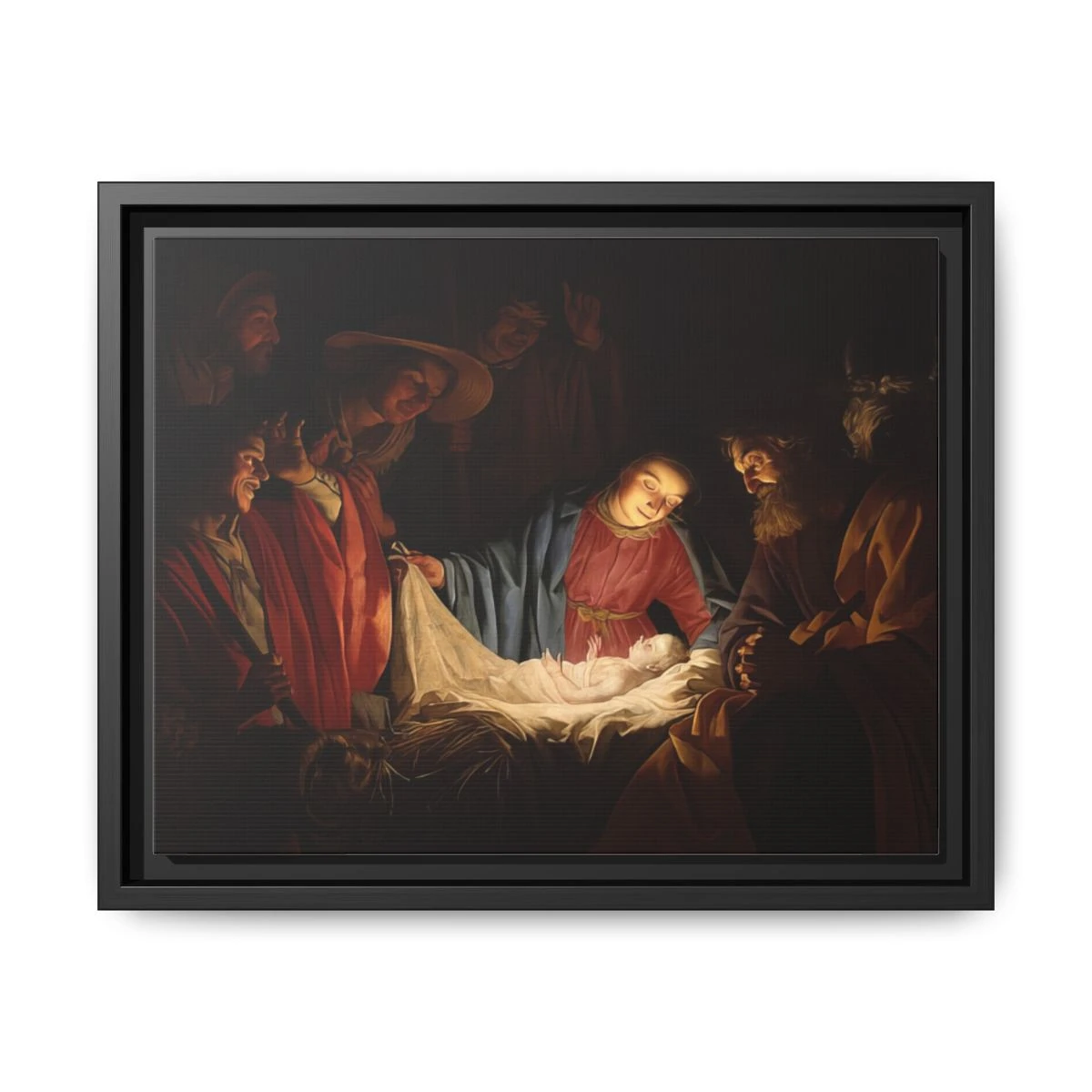Adoration of the Shepherds
Artist: Gerrit van Honthorst
Description: “Adoration of the Shepherds” (1622) by Gerrit van Honthorst is a Baroque oil painting depicting shepherds reverently visiting the newborn Christ.
Price: Select options to see price
Product Option:
Why You'll Love It
Gerrit van Honthorst’s "Adoration of the Shepherds" (1622): Art, Faith, and Illumination
The Artist: Gerrit van Honthorst
Gerrit van Honthorst (1592–1656) was a Dutch painter, renowned for his mastery of light and shadow. Born in Utrecht, Honthorst trained under Abraham Bloemaert before traveling to Italy. There, he encountered the works of Caravaggio, whose dramatic chiaroscuro techniques greatly influenced him. Honthorst became one of the leading members of the Utrecht Caravaggisti, a group of Dutch painters inspired by Caravaggio’s style. Returning to the Netherlands, Honthorst gained prominence for his vibrant biblical scenes, genre pictures, and portraits, earning the nickname "Gherardo delle Notti" or "Gerard of the Nights" for his nocturnal scenes illuminated by artificial light.
Historical Context
The early 17th century was a pivotal era in European art. The Dutch Republic was thriving economically and culturally, providing fertile ground for painters. Protestantism dominated the region, but religious artworks, especially biblical narratives like the Nativity, retained enormous cultural significance. Honthorst painted "Adoration of the Shepherds" in 1622, shortly after returning from Italy. At this time, artists were increasingly interested in depicting religious stories with emotional immediacy and naturalism, aligning with the Counter-Reformation’s emphasis on accessible, moving spiritual imagery.
Religious and Cultural Significance
"Adoration of the Shepherds" captures the moment when humble shepherds visit the newborn Christ in Bethlehem, as recounted in the Gospel of Luke. This scene signifies God’s revelation to the lowliest members of society, contrasting the shepherds’ poverty with the divinity of Jesus. For Christian audiences of the 17th century, the painting reinforced ideas of humility, hope, and divine intervention. In Protestant regions, the focus on biblical narratives in visual culture provided a vital means of religious expression and personal devotion, even as overtly Catholic iconography waned.
Symbolism and Iconography
Honthorst’s painting is dense with traditional Nativity symbolism:
- Light as Divine Presence: Central to the composition is the radiant Christ child, his body seemingly emitting light that illuminates the entire scene. This motif, echoing Caravaggio, symbolizes Christ as the "Light of the World," a theological concept drawn from John 8:12.
- Shepherds’ Awe: The shepherds are depicted with expressions of astonishment and reverence, emphasizing the wonder of the Incarnation. Their humble clothing and rugged appearance underscore the universality of Christ’s message.
- Virgin Mary: Mary is shown cradling Jesus, her face tender and contemplative, exemplifying maternal devotion and the fulfillment of Old Testament prophecy.
- Joseph and Angels: Joseph stands nearby, contemplative and protective, while angels above celebrate the miraculous birth. Often, angels are depicted in such scenes to reinforce the sacredness of the event and act as intermediaries between heaven and earth.
- Still Life Elements: The inclusion of everyday objects—such as the manger, straw, and simple garb—grounds the scene in material reality, making the miraculous accessible and relatable to viewers.
Artistic Techniques
Honthorst’s "Adoration of the Shepherds" is a masterclass in Baroque painting, characterized by:
- Chiaroscuro: Inspired by Caravaggio, Honthorst employs dramatic contrasts between light and shadow to heighten emotional and spiritual tension. The darkness enveloping the outer edges of the scene intensifies the supernatural radiance emanating from the Christ Child.
- Naturalism: The figures’ gestures, expressions, and details are rendered with striking realism. Honthorst captures varied psychological states—adoration, wonder, reflection—drawing viewers into the narrative.
- Composition and Focus: Honthorst arranges his figures around the infant Jesus in a circular, intimate configuration. This compositional device directs all attention to the focal point—the Child—ensuring the theological message is unambiguous.
- Color Palette and Texture: Warm earth tones dominate, reinforcing the nocturnal intimacy of the scene. The play of soft and hard textures, from the swaddling cloth to the shepherds’ garments, adds tactile realism and depth.
- Luminosity: The illusion of real, warm candlelight lends the painting a sense of immediacy and physical presence, a hallmark of Honthorst’s mature style.
Cultural Impact
Honthorst’s "Adoration of the Shepherds" has enjoyed enduring acclaim as a quintessential example of Dutch Caravaggism. Its influence can be seen in the work of later artists both within and beyond the Netherlands, including Rembrandt and Georges de La Tour.
The painting captures the shift in 17th-century religious art towards greater emotional resonance, accessibility, and realism. For audiences past and present, Honthorst’s treatment of the Nativity elevates the simple act of veneration into a universal human experience, bridging the divine and the everyday. Modern viewers are still drawn to his skillful manipulation of light and his authentic, unaffected portrayals of faith and wonder.
As art historians continue to explore Honthorst’s legacy, "Adoration of the Shepherds" stands as a powerful testament to the artist’s ability to convey theological truths and human emotion through virtuoso technique and deeply felt storytelling.
Sources
- Campbell, Gordon. The Grove Encyclopedia of Northern Renaissance Art. Oxford University Press, 2009.
- Liedtke, Walter. Dutch Paintings in the Metropolitan Museum of Art. Yale University Press, 2007.
- The Uffizi Galleries. "Adoration of the Shepherds" by Gerrit van Honthorst
- The National Gallery, London. "Gerrit van Honthorst"
- Ebert-Schifferer, Sybille. Caravaggio: The Artist and His Work. Getty Publications, 2012.
Who Made It
Created by Gerrit van Honthorst.
All Available Options
Below is a list of all the available options for this product. If you don't see what you're looking for, please contact us.
Shipping & Returns
All items are custom-made just for you! We partner with JonDo for fulfillment, and your order will typically arrive within 2-5 days. Since each piece is crafted to order, we don't offer returns, but we've got your back—if there's a defect or an issue caused by us or shipping, we'll do our absolute best to make it right. Questions? Feel free to reach out!
